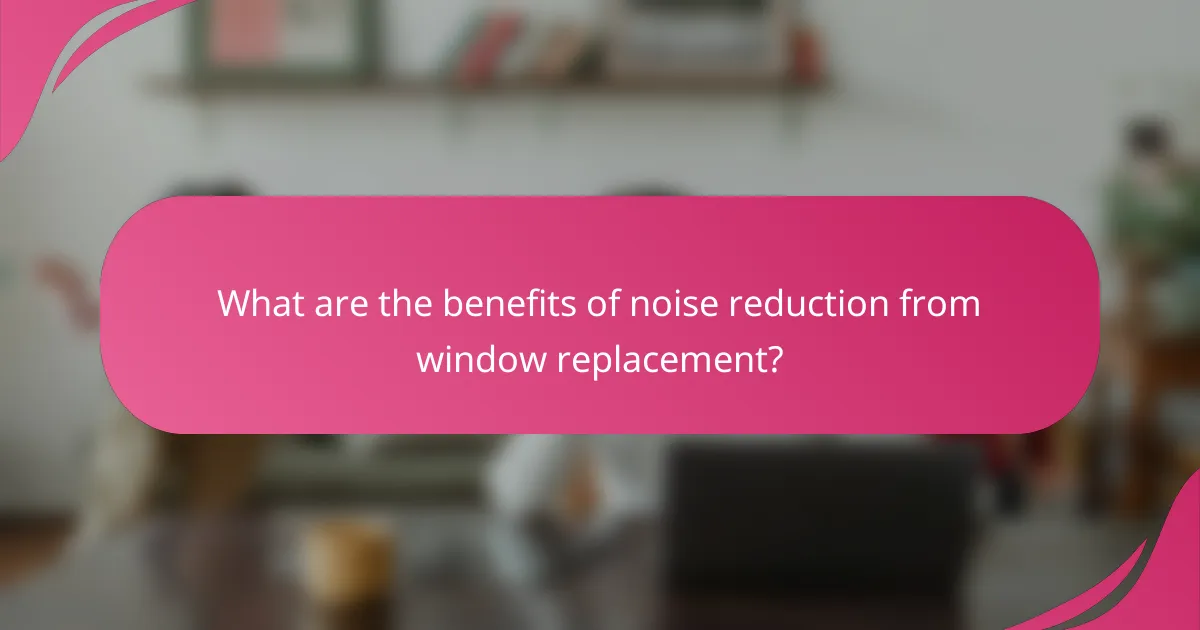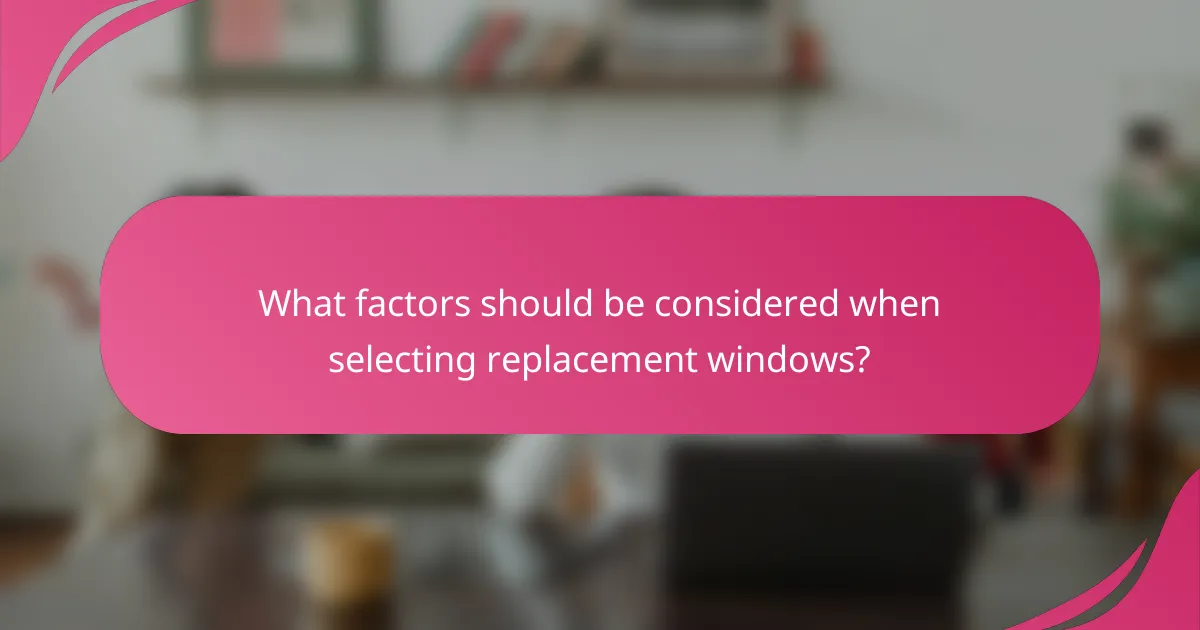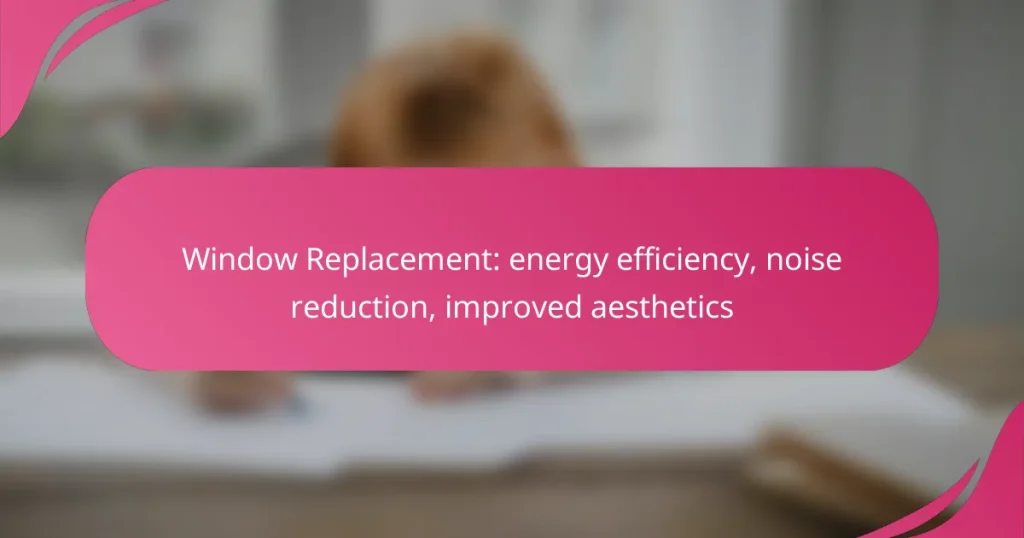Replacing windows in your home offers numerous benefits, including enhanced energy efficiency, reduced noise levels, and improved aesthetics. Modern window technologies minimize heat loss, leading to lower energy bills, while advanced designs effectively block external sounds for a quieter living environment. Additionally, upgrading your windows can transform the visual appeal of your home, making it more inviting both inside and out.

How does window replacement improve energy efficiency in Canadian homes?
Window replacement enhances energy efficiency in Canadian homes by minimizing heat loss and reducing energy consumption. New windows are designed with advanced technologies that help maintain indoor temperatures, leading to lower heating and cooling costs.
Low-E glass technology
Low-Emissivity (Low-E) glass is a type of window glazing that reflects heat while allowing light to enter. This technology helps keep homes warmer in the winter and cooler in the summer, significantly reducing energy use. Homeowners can expect energy savings of around 10-15% when upgrading to Low-E glass.
When selecting Low-E windows, consider the climate zone in Canada. For colder regions, choose windows with a higher solar heat gain coefficient (SHGC) to maximize warmth from sunlight during winter.
Insulated frames
Insulated frames are designed to reduce thermal bridging, which occurs when heat escapes through the frame material. Frames made from materials like vinyl or fiberglass offer better insulation compared to traditional wood or aluminum frames. This can further enhance the overall energy efficiency of the window system.
When replacing windows, look for frames with a high R-value, which indicates better insulating properties. This can lead to improved comfort and lower energy bills over time.
Energy Star certification
Energy Star certification indicates that windows meet strict energy efficiency guidelines set by Natural Resources Canada. Choosing Energy Star-rated windows ensures that you are investing in products that will help reduce energy costs and environmental impact.
To qualify for Energy Star certification, windows must pass rigorous testing for performance in various climates. Homeowners should check for the Energy Star label when shopping for new windows to ensure they are making an efficient choice.

What are the benefits of noise reduction from window replacement?
Replacing windows can significantly reduce noise levels in your home, enhancing comfort and tranquility. Improved window designs, such as double-glazing and specialized acoustic options, effectively block external sounds, making your living space quieter.
Double-glazed windows
Double-glazed windows consist of two panes of glass separated by a space filled with gas, which acts as insulation against sound. This design can reduce noise transmission by up to 30% compared to single-pane windows. When considering replacement, look for models with a wider gap between panes for better soundproofing.
In addition to noise reduction, double-glazed windows also improve energy efficiency, helping to maintain indoor temperatures and potentially lowering heating and cooling costs. This dual benefit makes them a popular choice for homeowners.
Acoustic window options
Acoustic windows are specifically designed to minimize sound transmission, often featuring thicker glass and advanced sealing techniques. These windows can reduce noise levels by a greater margin than standard double-glazed options, making them ideal for homes in noisy environments, such as near busy roads or airports.
When selecting acoustic windows, consider the Sound Transmission Class (STC) rating, which indicates how well a window blocks sound. Higher STC ratings generally mean better noise reduction, so aim for windows with ratings above 35 for effective soundproofing.
Sealing and insulation improvements
Proper sealing and insulation around windows are crucial for maximizing noise reduction. Gaps and leaks can allow sound to penetrate, undermining the benefits of new windows. Ensure that the installation includes high-quality weather stripping and caulking to create a tight seal.
Regular maintenance of seals is also important. Inspect and replace worn or damaged seals to maintain optimal noise reduction performance over time. This proactive approach can help sustain a peaceful indoor environment and enhance the longevity of your window investment.

How can window replacement enhance home aesthetics?
Window replacement can significantly improve the visual appeal of a home by introducing modern designs and customizable options. Upgrading windows not only enhances the exterior look but also contributes to a more inviting interior atmosphere.
Modern frame designs
Modern frame designs offer sleek lines and minimalist aesthetics that can elevate the overall appearance of a home. Options like narrow frames or frameless glass can create a contemporary look, making the windows a focal point rather than just functional elements.
When selecting modern frames, consider materials such as aluminum or fiberglass, which provide durability and a clean finish. These materials can be tailored to fit various architectural styles, ensuring a cohesive look throughout the property.
Customizable styles and colors
Customizable styles and colors allow homeowners to match windows with their personal taste and the home’s architecture. From traditional double-hung windows to modern casement styles, the variety available can cater to any design preference.
Choosing colors that complement the exterior paint or siding can enhance curb appeal. Many manufacturers offer a range of finishes, including wood-like textures and vibrant hues, enabling homeowners to create a unique look that stands out in the neighborhood.
Increased natural light
Replacing windows can increase the amount of natural light entering a home, making spaces feel larger and more inviting. Larger panes of glass or strategically placed windows can brighten rooms and reduce reliance on artificial lighting during the day.
Consider options like bay or bow windows, which extend outward and allow more light to flood in. Additionally, installing skylights can bring light into areas that may not have direct access to exterior walls, enhancing the overall ambiance of the home.

What factors should be considered when selecting replacement windows?
When selecting replacement windows, consider material types, energy ratings, and the balance between cost and long-term savings. Each factor plays a crucial role in enhancing energy efficiency, reducing noise, and improving the overall aesthetics of your home.
Material types
The choice of material for replacement windows significantly impacts durability, maintenance, and insulation properties. Common materials include vinyl, wood, aluminum, and fiberglass, each offering distinct advantages. For instance, vinyl is often favored for its low maintenance and energy efficiency, while wood provides a classic look but requires more upkeep.
When selecting materials, consider your local climate and the architectural style of your home. In areas with extreme weather, materials with high insulation properties, like fiberglass, may be more beneficial.
Energy ratings
Energy ratings are essential for assessing how well windows insulate your home. Look for the Energy Star label, which indicates compliance with energy efficiency standards. Additionally, pay attention to U-factor and Solar Heat Gain Coefficient (SHGC) ratings, as these metrics reflect how well windows resist heat transfer and solar radiation.
In general, lower U-factor values indicate better insulation. For example, a U-factor below 0.30 is typically considered efficient for most climates. Choosing windows with high energy ratings can lead to reduced heating and cooling costs over time.
Cost vs. long-term savings
While the initial cost of replacement windows can vary widely, it’s crucial to weigh this against potential long-term savings on energy bills. High-quality windows may have a higher upfront price but can save homeowners significant amounts over their lifespan through improved energy efficiency.
For example, investing in energy-efficient windows can yield savings of 10-20% on heating and cooling costs annually. Consider the payback period for your investment, which can typically range from 5 to 15 years, depending on the efficiency of the windows and local energy prices.

What are the costs associated with window replacement in Canada?
The costs of window replacement in Canada can vary significantly based on factors such as the type of windows, installation complexity, and regional labor rates. Homeowners should expect to invest anywhere from a few hundred to several thousand Canadian dollars per window, depending on these variables.
Average installation costs
Installation costs for window replacement typically range from CAD 150 to CAD 300 per window. This price can fluctuate based on the window type, the number of windows being replaced, and the specific contractor hired. Complex installations, such as those requiring structural changes, may incur higher labor costs.
It’s advisable to obtain multiple quotes from local contractors to ensure competitive pricing and to check their references and past work to gauge quality.
Cost of materials
The cost of window materials can vary widely, with prices generally falling between CAD 300 and CAD 1,500 per window. Common materials include vinyl, wood, and fiberglass, each with distinct price points and energy efficiency ratings. For instance, vinyl windows are often more affordable and require less maintenance, while wood windows can provide better aesthetics but at a higher cost.
When selecting materials, consider not only the upfront cost but also the long-term energy savings and maintenance requirements associated with each type.
Potential rebates and incentives
Homeowners in Canada may qualify for various rebates and incentives when replacing windows, particularly if they choose energy-efficient options. Programs offered by the federal government, provinces, or local utilities can help offset costs, often providing rebates of CAD 100 to CAD 500 per window.
To take advantage of these incentives, check with local energy efficiency programs and ensure that the windows meet specific energy performance standards. Keeping documentation of purchases and installations will also facilitate the rebate process.

